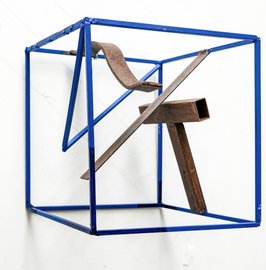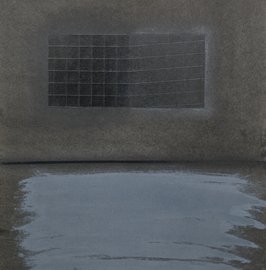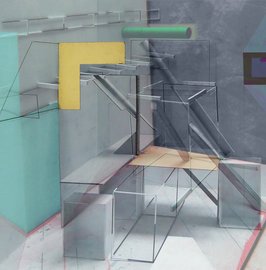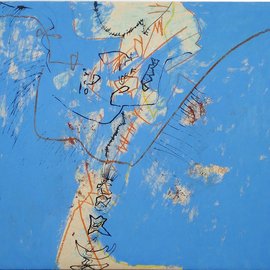Subgallery
Kjell Varvin
I met Kjell Varvin in 2015 at the Arctic Arts Festival. Shortly afterwards, we travelled together in a van to Tromsø to bring one of his sculptures to the Northern Norway Art Museum. This encounter was the beginning of an extraordinary friendship and collaboration. In 2016 I curated the exhibition Kjell Varvin:Free Geometry.
- Image 1: Cubic Fragments Combined, 2018, painted iron
- Image 2: Piscine, 1974, polished graphite, gouache and pencil
- Image 3: Multiinstall, 2013, digital print
- Image 4: Lerkesang, 1971, gouache, ink, grease crayon on paper
Recycled art in a digital era
Subgaze.com presents a selection of works by the Norwegian multimedia artist. In addition to drawings, prints, paintings and installations, Kjell Varvin has been producing iron sculptures in various sizes and designs since 1993. Cubic Fragments Combined from 2018 can be mounted on walls in various ways. In the tradition of Arte Povera he uses second-hand materials in addition with an ultramarine paint finish, providing a refinement to the sculpture.
- Image 5 – 6: Autumn Dance 1 and 2, 2017, ink, grease chalk and pencil on paper
- Image 7: Cruise, 1976, silkscreen
- Image 8: Svev (Aria), 1981
Performative Minimal Art
Since the 1970s, Varvin's style has been characterised by geometry and reduced use of colour. Formally, the early work in particular is reminiscent of Bauhaus, De Stijl and the Russian avant-garde of the 1920s. Rare works such as the silkscreen Cruise from 1976 also reveal a proximity to Surrealism.
The print Piscine from 1974 shows both the influence of US-American Minimal Art and the artist's preference for a variety of materials. Using graphite, pencil and gouache, he achieves the maximum range of colour qualities and surfaces that dark tones yield. Alternately matt and glossy, the picture surfaces alternate so that the overall impression changes depending on the angle of view.
Changeability is a special feature of the art of Kjell Varvin, whose main work consists of short-lived installations. Since the 1990s, the artist has also experimented with digital media and image processing programmes. A constant testing of new possibilities and perspectives characterises Kjell Varvin's working method. Material combinations with filigree details create poetic moments.
![[Translate to English:] Kjell Varvin, Northern Norway Art Museum [Translate to English:] Kjell Varvin, preparing the exhibition at the Northern Norway Art Museum.](/fileadmin/_processed_/a/b/csm_SG_Portrait_Kjell_0c0d1c5bb1.jpg)
Kjell Varvin
A Bohemian of the Avant-garde
Varvin was born in Bærum near Oslo in 1939. From 1958 he attended the Norwegian Academy of Arts and Crafts and Art Industry in Oslo. Travelling through Southern Europe, he then continued his studies at the Ecole Supérieure des Beaux-Arts in Paris, the Academia Bellas Artes in Seville, the Academia Bellas in Porto and the Escuela de Artes y Oficios in Barcelona. Study trips through Asia, Central America and the USA provided an early acquaintance with different cultures.
In the artistic studio in Høvik, new short-lived installations are created daily and systematically archived as digital photographs. The artist avoids dramatic stagings and prefers the even and uncontrollable effect of natural lighting.



